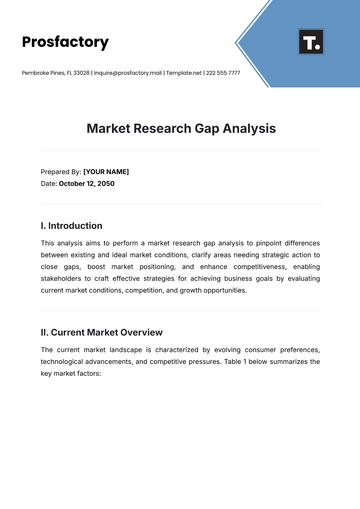Market Research Gap Analysis
Prepared By: [YOUR NAME]
Date: October 12, 2050
I. Introduction
This analysis aims to perform a market research gap analysis to pinpoint differences between existing and ideal market conditions, clarify areas needing strategic action to close gaps, boost market positioning, and enhance competitiveness, enabling stakeholders to craft effective strategies for achieving business goals by evaluating current market conditions, competition, and growth opportunities.
II. Current Market Overview
The current market landscape is characterized by evolving consumer preferences, technological advancements, and competitive pressures. Table 1 below summarizes the key market factors:
Factor | Description |
|---|
Market Size | Estimated at $10 billion, with a growth rate of 5% annually. |
Consumer Preferences | Increasing demand for sustainable and ethically produced products. |
Technological Integration | High adoption of digital solutions and e-commerce platforms. |
Regulatory Environment | Stricter regulations focus on data privacy and environmental compliance. |
III. Desired Market State
The desired state of the market envisions a scenario where businesses not only meet but anticipate consumer needs, leading to increased market share and customer loyalty. Key attributes of this desired state include:
Enhanced customer engagement through customized marketing strategies.
Leadership in innovation with an expanded digital presence.
Achieving an average market growth rate exceeding 7% annually.
Compliance with emerging global standards and regulations seamlessly.
IV. Identified Gaps
An analysis of the current versus desired market state reveals several gaps as illustrated in Table 2:
Current State | Desired State | Gap |
|---|
Growth Rate: 5% | Growth Rate: >7% | 2% increase needed |
Basic Digital Presence | Expanded Digital Engagement | Need for digital transformation |
Partial Regulatory Compliance | Full Compliance | The gap in regulatory adherence |
V. Competitive Landscape
The competitive landscape is marked by the presence of established players and emerging companies that leverage innovation to gain market share. Key competitors and their positioning are summarized below:
Company A: Leading e-commerce platform with a broad product range.
Company B: A fast-growing new entrant known for sustainable products.
Company C: Focuses on niche markets with specialized offerings.
Company D: Strong digital marketing strategies, but limited product range.
VI. Recommendations
To address the identified gaps and transition towards the desired market state, the following recommendations are put forth:
VII. Conclusion
In conclusion, this analysis highlights the strategic imperatives necessary to bridge the gap between the current and desired market states. By addressing the key gaps in growth rate, digital engagement, and regulatory compliance, businesses can enhance their competitive positioning and meet future market demands. The next steps involve implementing the outlined recommendations with periodic reviews to ensure alignment with market dynamics and objectives.
Analysis Templates @ Template.net






























